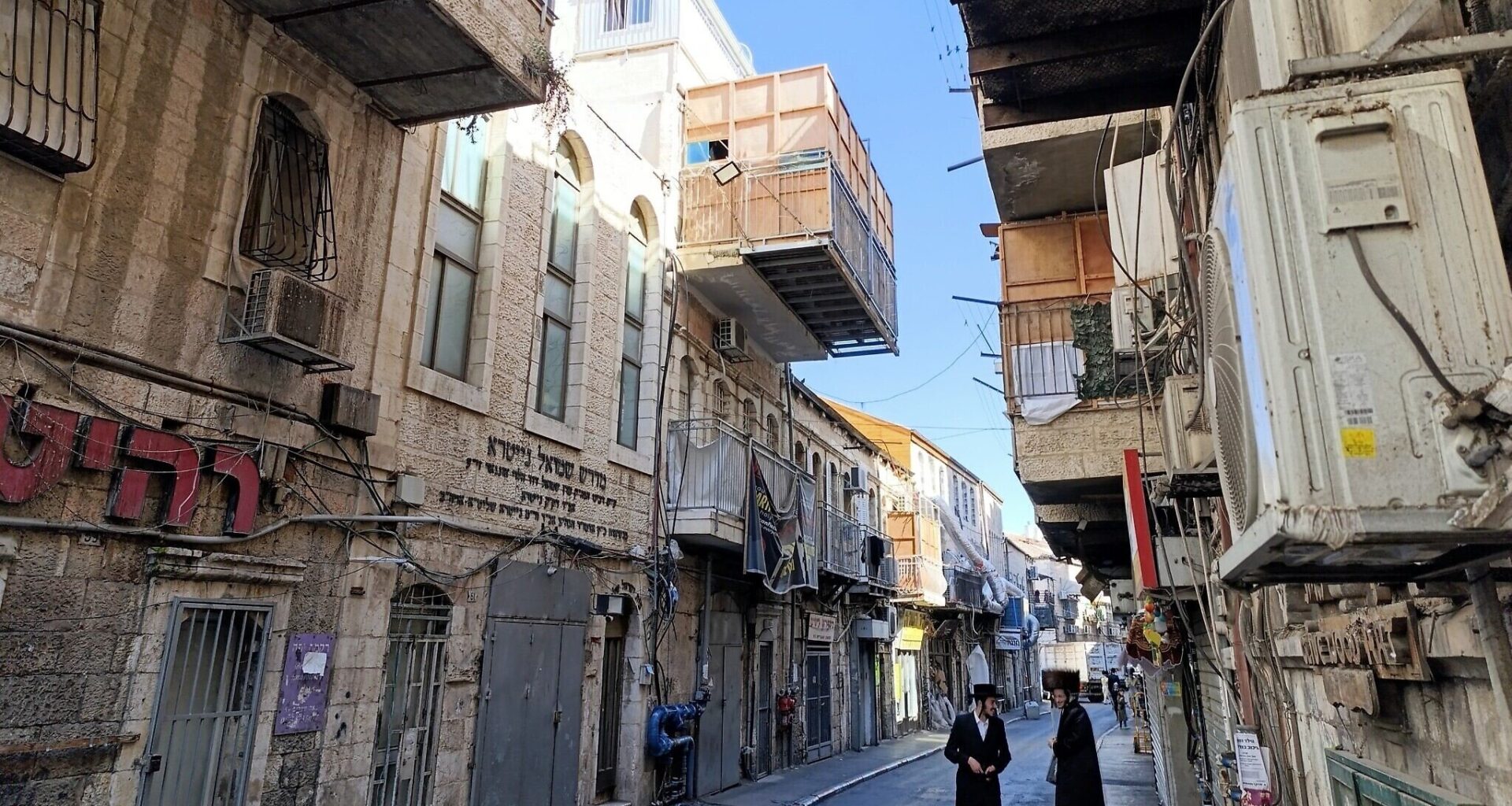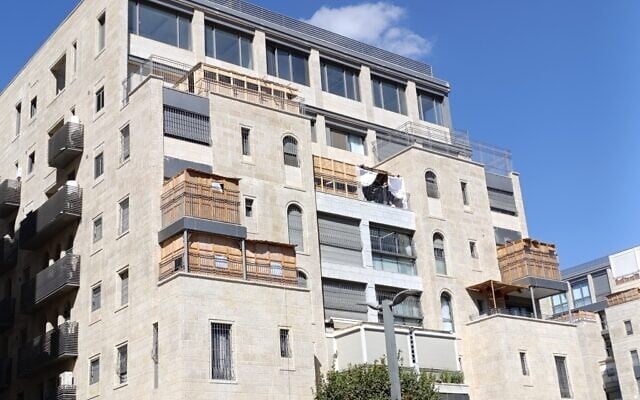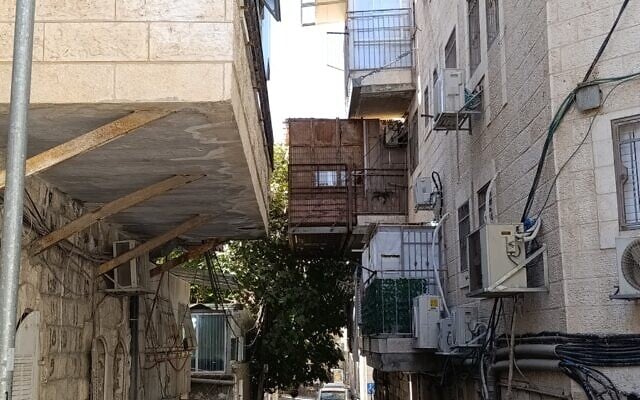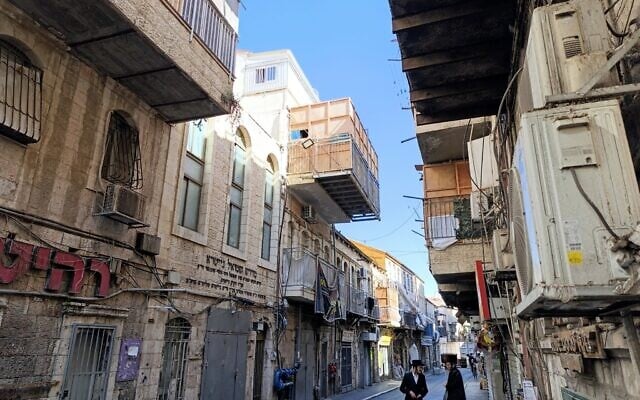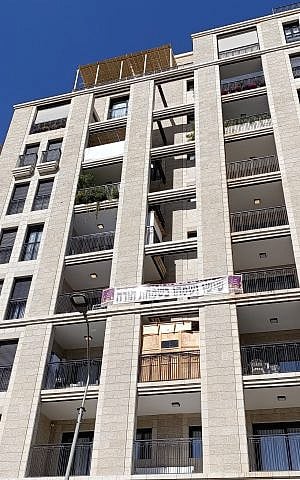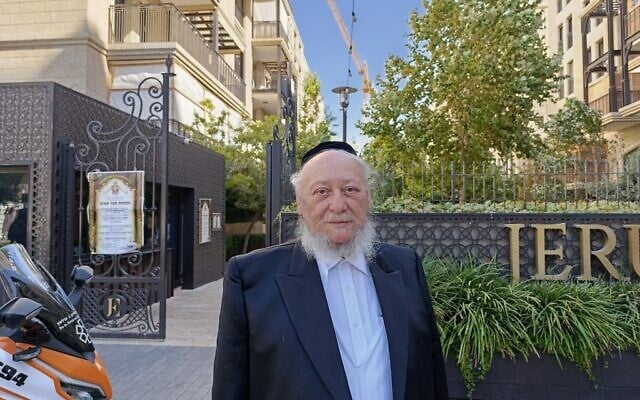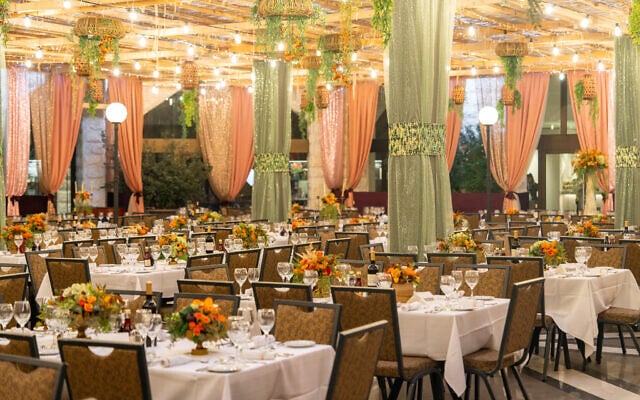For residents of Jerusalem’s ultra-Orthodox Meah Shearim neighborhood, the holiday of Sukkot is a highlight of the entire year. Referred to by the rabbis as “the time of our joy,” music pours through the storied commercial streets as families walk out in their finest clothing — men in black coats, women in long dresses, and children in matching outfits. Many clutch the four species, including tall palm branches and bright yellow citrons, used in the holiday prayers.
And of course, sukkot, the festive booths for which the holiday is named, are hanging off balconies everywhere.
With a biblical commandment to eat and sleep in these outdoor huts for seven days, and with space at a premium in crowded urban areas like this, having a sukkah on your balcony is the ultimate luxury for the holiday. The stipulation that the roof of the sukkah must look directly up to the sky, with no other balconies or other interferences between it and the heavens, adds a level of complexity to the holiday and a fascinating engineering challenge.
“Every building has its own footprint, and when you are designing a building for construction, any balcony reduces the amount of space that is available inside apartments,” explained Josh Skarf, a Jerusalem-based architect and author of a book investigating biblical concepts through the lens of architecture. “If you are concerned about leaving balconies open to the sky above, then every space that you’re using for a balcony eliminates not only that space but also the space above it. You end up building in tiers, getting narrower toward the top like a wedding cake, and that reduces the number of apartments that you can sell.”
Sukkot near the Meah Shearim neighborhood in Jerusalem, October 8, 2025 (Zev Stub/Times of Israel)
But not everyone lives in an apartment optimized for Sukkot dwellings. Around Israel, and particularly in dense Haredi communities like those around Meah Shearim, sukkot built on unauthorized jerry-rigged temporary balconies are everywhere, often constructed with crude techniques that fall far short of best building practices. Those standing on pillars are generally safer than those built on a cantilever, Skarf noted.
Sign up for ToI’s free
Real Estate Israel newsletter
By signing up, you agree to the terms
Some look like disasters waiting to happen, with their fearless occupants living on a prayer.
“After the Jewish people’s sins have been forgiven on the holiday of Yom Kippur, sitting in the sukkah is a sign that we trust the Holy One will protect us from calamity,” commented a bystander looking at a sukkah hanging over the street from a balcony extended by steel scaffolding. “There is no need to be afraid.”
A sukkah built on a temporary balcony around the Meah Shearim neighborhood in Jerusalem, October 8, 2025 (Zev Stub/Times of Israel)
Not everyone relies only on heavenly favor. The Jerusalem municipality says that while it doesn’t issue approvals for these temporary platforms, it does monitor them for safety, with a team of police dedicated to checking the integrity of these crude balconies. This arrangement has been in place for many years, with good results, a city spokesperson said.
“We are not aware of any sukkah existing in Jerusalem that endangers human life,” the municipality told The Times of Israel in a statement. “Should such a sukkah be erected, the municipality would take immediate action to enforce its removal in accordance with the law.”
An emergency responder for the volunteer Tzevet Hatzalah organization operating in the neighborhood offered additional assurances that there was no need to worry. Everyone who builds such platforms hires the services of a qualified engineer, and until now, no tragedies involving collapsed sukkahs have taken place, he said.
One can only hope he is right.
A sukkah built on a temporary balcony around the Meah Shearim neighborhood in Jerusalem, October 8, 2025 (Zev Stub/Times of Israel)
Several blocks from the crowded, disheveled old streets of Meah Shearim’s commercial center, new luxury buildings glisten in the sun, highlighting sharp economic divides within the Haredi community.
A sukkah balcony with empty spaces above, allowing the sukkah to be directly under the sky, at the Cardo shopping promenade at the Jerusalem Estates, October 8, 2025 (Zev Stub/Times of Israel)
At the Jerusalem Estates, large gardens with well-kept playgrounds lie between buildings designed for ultra-Orthodox residents. Spacious, privately built sukkot stand in front of buildings in the public space, while others sit on balconies strategically designed to maximize space, as Skarf described.
At the Cardo shopping promenade across the street, apartments several flights below the penthouse have balconies with empty spaces above them, creating unique corridors that enable the construction of a kosher sukkah at the expense of multiple balconies above.
For the wealthy ultra-Orthodox buyer, a sukkah balcony is a non-negotiable resource, sometimes increasing a home’s value by as much as 5%. Even in less exclusive developments, it can add upwards of NIS 100,000 ($30,000) to the value of an apartment, according to Nachi Paris, owner of Nachi Realty in Jerusalem.
“Everyone should strive to have a beautiful sukkah, in accordance with the size of their families and what they can afford,” said Isser Oppenheim, a Beit Shemesh resident who was visiting friends at the Jerusalem Estates. “It’s a beautiful mitzvah whose joy brings increased holiness.”
Isser Oppenheim at the Jerusalem Estates, October 8, 2025 (Zev Stub/Times of Israel)
Sukkah balconies started to come into style in Israel in the 1990s, and are now in high demand in many cities around the country, not just ultra-Orthodox ones. In Herzliya and Tel Aviv, some buildings as tall as 15 stories have been designed with Sukkah balconies in mind, and in Or Yehuda, a city of 40,000 in the center of the country, the local building and planning committee recently ruled that up to 30% of the balconies in new urban renewal projects should be sukkah balconies.
However, the innovation is neither new nor distinctly Israeli. In Brooklyn, New York, hassidim in the neighborhood of Williamsburg have been living for decades in brownstone buildings with staggered balconies designed for the Sukkot holiday.
Sukkah balconies also existed in pre-war Krakow and other European towns with large Jewish communities, according to Haredi historian and podcaster Yehuda Geberer.
The main sukkah at The Inbal hotel in Jerusalem, Sukkot 2025 (The Inbal/Oz Ohayon)
Today, many of Jerusalem’s luxury hotels offer private Sukkah balconies for their most exclusive suites, at prices even higher than regular rooms during the holiday. Guests can use these for private gatherings, separate from the communal hotel sukkot, which are often exquisitely decorated themselves.
“There are a lot of economic considerations to these sukkot, so people have given them a lot of thought,” Skarf said. “It’s interesting to see some of the rich and novel solutions people have come up with the enjoy the holiday.”
